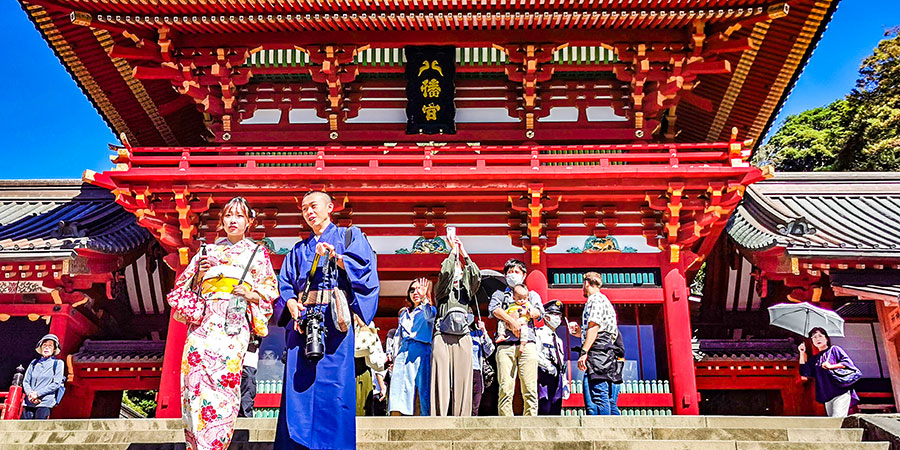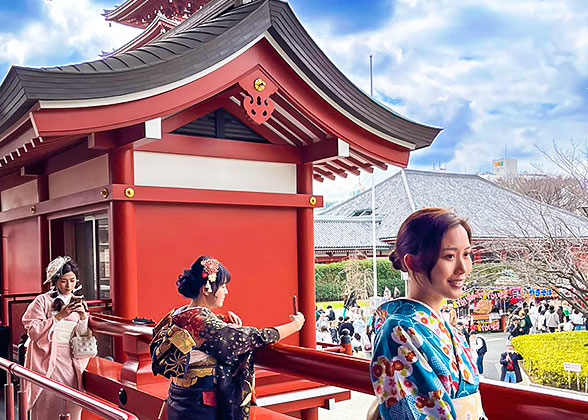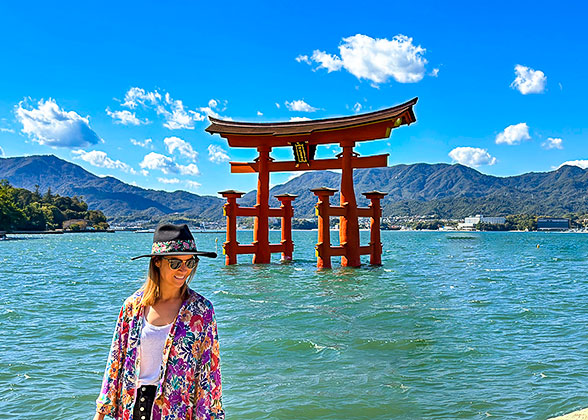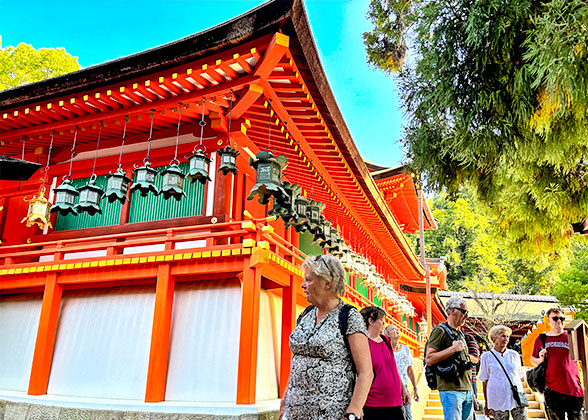- Tsurugaoka Hachimangu Shrine
- Enoshima Island
- Enoshima Jinja Shrinejia
- Kamakura Daibutsu
- Kamakurakoko-Mae Station
Tsurugaoka Hachimangu Shrine
The 800-year-old Tsurugaoka Hachimangu Shrine is one of Japan’s three greatest Hachimangu Shrines where god Hachiman kami is worshiped. As the patron saint of samurais, the god also blesses the region’s good fortune in warfare, as well as the agricultural production. In addition, he is seen as the avatar of Emperor Ojin, Empress Jingu, and Himegami, all are Japanese royal members in the 15th century and worshiped in the Shrine.The Shrine itself is spoken highly of its delicate shrine buildings, monthly rituals, national treasures from ancient weapons to paintings and crafts, and amulets of different shapes. Local people come here for different wishes, like business prosperity. Due to its sacred atmosphere, many people hold their weddings here.

The Main Shrine of Tsurugaoka Hachimangu Shrine
|
Main Shrine Buildings to See
Tsurugaoka Hachimangu Shrine preserves 9 main buildings, among which the Main Shrine, Wakamiya, and Maruyama Inari Shrine are identified as National Important Cultural Properties by the Japanese Government.1. Main Shrine and Wakamiya – Typical Japanese Shrine Buildings
The two sites are great places to feel Japan’s shrine culture. In these two red shrine buildings, Emperor Ojin, Himegami, Empress Jingu, Emperor Nintoku, Empress Nakatsuhime no Mikoto, and Empress Iwa no hime, these famous historical figures are enshrined.

Main Building Observed at Close Distance
|
2. Maruyama Inari Shrine – Praying for Business Prosperity
It is the oldest building in Tsurugaoka Hachimangu Shrine dating to the Muromachi Period (1336 – 1573) and is popular mainly among businessmen. Numerous red flags are hung on the building, which are donated by visitors who pray for prosperous business in the future.3. Shirahata Shrine and Hataage Benzaiten Shrine – Wishing Academic Progress
Shirahata Shrine is popular especially among students, and many of them come here to pray for academic progress. The black Shirahata Shrine looks unique among a series of red shrine buildings. Want to pray for something else like finding a good job or safe delivery, then you can go to Hataage Benzaiten Shrine, and make wishes towards the two-striped banner.
|
|
|
What Else to See
1. National Treasures
Many collections displayed in Tsurugaoka Hachimangu Shrine are designated as National Treasure by Japanese Government. They are mainly weapons, including one sword – Tachi Mei Masatsune, three black lacquer arrows, and one red lacquer bow. Apart from weapons, some other kinds of relics are worth your attention, such as art crafts, religious items, and calligraphy works. There is also one Bodhisattva Mask, five Bugaku Masks, one wooden seated Sarasvati, and Series of Tsurugaoka Hachimangu Documents well preserved there.

One Building in Tsurugaoka Hachimangu Shrine
|
2. The Great Stone Steps
The Great Stone Steps is the symbol of the Shrine. After climbing hundreds of stone steps to the top, visitors can watch the panorama of the whole Kamakura, even the Pacific Ocean and Izu Oshima Island.

The Great Stone Steps in Tsurugaoka Hachimangu Shrine
|
3. The Peony Garden and the 1,000-year-old Gingko Tree
The Peony Garden in Tsurugaoka Hachimangu Shrine is one of the three most beautiful peony gardens in Japan. Not like other regions in Japan where peonies flower in March and April, January and February are the best time to see the peony blossoms here like New Year's peonies and spring peonies of different colors. The 30-meter-high (100 feet) ginkgo tree is also worth seeing as it has more than 1,000 years of history, but still growing lushly.Recommended Rituals
All year around, Tsurugaoka Hachimangu Shrine holds a series of festivals or rituals. For example, in January, there is the New Year’s Day Festival, the Start of Carpentry Work Ceremony, and Dispelling Evil with Sacred Arrows. Here are two interesting festivals.1. Cricket Release Festival
Every September 16, Cricket Release Festival is held in Yanagihara-shinchi Pond. On that day, you can see music and dancing shows performed by maidens. After that, the bell crickets would be released from cages into nature.2. Yabusame Horseback Archery Ritual
Yabusame Horseback Archery Ritual is also held on September 16 in Horseback Archery Range. This martial arts performance has a history of more than 800 years. On that day, performers would dress like ancient samurais and shoot arrows on the horse. You would feel Japanese samurai spirit while watching this magnificent performance.Other Activities in the Shrine
1. See Traditional Japanese Weddings
Many Japanese people hold their weddings in Tsurugaoka Hachimangu Shrine. You can see bridegrooms and the brides in traditional Japanese clothes and watch the whole process of a traditional Japanese wedding. Remember that weddings are usually held in Maiden on weekends.2. Buy a Amulet for Yourself and People you Love

The Amulets in Tsurugaoka Hachimangu Shrine
|
Tsurugaoka Hachimangu Shrine offers amulets of different functions, such as the Job Security Amulet, Safe Delivery Amulet, Enchanted Tree Amulet which blesses people to find lovers, and Warding-Off Evil Arrow Amulet which blesses people away from danger. In addition, there are some amulets of different shapes children may like, including the dove-shaped ones, the crane-shaped ones, and the ginkgo-tree-leaf-shaped ones.
3. Taste Free Sake on January 1st
In the Shrine, there is a wall made up of dozens of barrels of sake. There is a tradition that on January 1st, visitors can taste these sake for free.Opening Hours
April – September: 6 a.m. – 9 p.m.October – March: 5 a.m. – 9 p.m.
Treasure Hall: 9 a.m. – 4 p.m.
How to Get There
Take a train of Enoden Line/ Shonan-Shinjuku Line/ Yokosuka Line and get off at Kamakura Station. Later, walk for 1 minute to the nearby bus stop to take Bus N2 running towards northeast along the Wakamiya oji Street, and then get off after 2 stops. Last, you can walk to the Shrine in 1 minute.Nearby Tourist Attraction
After visiting Tsurugaoka Hachimangu Shrine, it is recommended to visit Kamakura Daibutsu. Kamakura Daibutsu is the second-highest Buddha statue with about 1,000 years of history in Japan. It’s hallow and visitors can go inside to see many repairing traces. Also, don’t miss Nio-mon Gate or Kangetsu-do Hall around. Another thing to see is the pair of huge warazori donated to the big Buddha by local children.You May Like
-
 16 Days Japan & China Private Tour to Tokyo - Mt. Fuji - Kyoto - Osaka - Shanghai - Guilin - Xi'an - Beijing from USD4891
16 Days Japan & China Private Tour to Tokyo - Mt. Fuji - Kyoto - Osaka - Shanghai - Guilin - Xi'an - Beijing from USD4891 -
 7 Days Mini Group Tour with Highlights in Japan: Tokyo - Mount Fuji - Kyoto - Nara - Osaka from USD2155
7 Days Mini Group Tour with Highlights in Japan: Tokyo - Mount Fuji - Kyoto - Nara - Osaka from USD2155 -
 11 Days Mini Group Tour to Tokyo - Hakone (Mt. Fuji) - Kyoto - Nara - Osaka - Hiroshima - Kanazawa - Shirakawa-go - Takayama - Tokyo from USD3554
11 Days Mini Group Tour to Tokyo - Hakone (Mt. Fuji) - Kyoto - Nara - Osaka - Hiroshima - Kanazawa - Shirakawa-go - Takayama - Tokyo from USD3554

